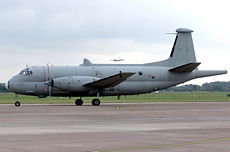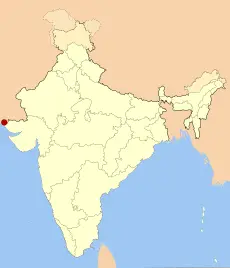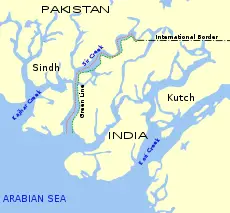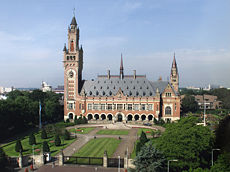Atlantique Incident
The Atlantique Incident was an event in which a Pakistan Navy plane, Breguet Atlantique, carrying 16 people on board, was shot down by the Indian Air Force citing violation of airspace. The episode took place in the Rann of Kutch on August 10, 1999 just a month after the Kargil War, creating a tense atmosphere between India and Pakistan. This was the Pakistan Navy's only loss of an airplane to hostile fire in its history.
The confrontation
The French-built naval plane Breguet Atlantique (Breguet Br.1150 Atlantique) plane, flight Atlantic-91,[1] was one of Pakistan Navy's frontline aircraft, used primarily for patrol and reconnaissance (though capable of being fitted with air-to-surface missiles and anti-submarine weapons). Atlantic-91 left Mehran (Sindh province) Naval Base in Pakistan at 9:15 a.m. (PST). An Indian Air Force ground radar picked up the flight path of the plane approaching the International Border.[2] Two IAF Mig-21 interceptor aircraft of No.45 Squadron, from the Indian airbase at Naliya in the Kutch region, were soon scrambled by the Indian Air Force.[3] After a series of manoeuvres—and a conflicting version of events from both sides—the two jets were given clearance to shoot down the Pakistani plane.[2] At 11:17 a.m. IST (10:47 a.m. PST), nearly two hours after takeoff from Pakistan, the Atlantique was intercepted and an infrared homing air-to-air missile was fired at it by Squadron Leader P.K. Bundela, hitting the engine on the port side of the plane.[4] This resulted in the aircraft losing control and spiralling towards a crash at approximately 1100 hours PST, killing all 16 on board the Atlantic-91, including five officers of the Pakistan Navy.
The incident was the Pakistan Navy's only loss of an aircraft to hostile fire in its history, and the biggest combat-related casualty for the navy since the Indo-Pakistani War of 1971.[5]
Claims and counterclaims
The event immediately sparked claims and counter-claims by both nations. Pakistan claimed that the plane was unarmed and the debris was found on Pakistan's side of the border,[6] and hence there was no violation of Indian airspace. According to the official Pakistan version of events, the plane was merely on "routine training mission inside Pakistan air space."[7][8] The Pakistani Prime Minister stated during the funeral service of the airmen that the shooting was a "a barbaric act."[9]
The Indian Air force, however, claimed that the aeroplane did not respond to international protocol and that the plane acted in a "hostile" manner, adding that the debris of a downed aircraft could fall over a wide radius.[10] Indian sources also state that the Pakistani Information Minister, Mushahid Hussein, was initially quoted by the BBC as saying that the aircraft was on a "surveillance" mission.[11] India also accused that the plane violated a bilateral agreement signed between India and Pakistan in 1991. The treaty states that no military aircraft is supposed to come anywhere near 10 km from the border.[12] Indian experts also questioned why a training mission was being done so close to international borders, since all air forces clearly demarcate training areas for flight, which are located well away from the borders. According to them, the Pakistani claim was untenable since the primary role of the Atlantique is for operations over the sea and that to carry out a training flight over land deep inside foreign territory was an indication of its use in a surveillance role.[11] India displayed part of the wreckage of the Pakistani naval aircraft at New Delhi airport the next day. Pakistan however, alleged that the wreckage was removed from its side of the border by Indian helicopters.[6]
While Pakistan said that the plane was unarmed and the debris was within Pakistani territory, India maintained that warnings had been given to the Atlantique and that its flight trajectory meant it could have fallen on either side of the border. According to the Indian version of events, the MiGs tried to escort it to a nearby Indian base, when the Pakistani aircraft turned abruptly and tried to make a dash for the border; it was only then that it was fired upon. India claimed that the debris was found in a radius of 2 km on either side of the border and that the intrusion took place 10 km inside the Kori Creek, which is Indian territory. Pakistan requested that the matter be taken up in the UN. Indian officials blamed that there had been previous violations in the area and pointed out that in the previous year a Pakistani unmanned surveillance aircraft had intruded 150 km inside the Indian border, coming close to the Bhuj air base before the IAF spotted it and brought it down with several missiles.[10] They further added that Pakistan military aircraft had violated Indian airspace at least 50 times since January 1999, showing videotapes of Pakistani Atlantiques "buzzing," or flying provocatively near the Indian Navy's warships in the Indian Ocean.[13] Some Indian analysts stated that the Atlantique was nearly destroyed in 1983 on a similar encounter and noted other close encounters and violations from Pakistani naval planes.[14][15][16]
Independent defence experts stated that the Atlantique was probably conducting a "probe" on India's air defence system, mainly the radar equipment in the border area; however, they advised that it was not part of any planned aggressive military action by Pakistan.[13] Foreign diplomats who visited the crash site noted that the plane "may have strayed into restricted space," and that Islamabad was unable to explain why it was flying so close to the border; they however added that India's reaction to the incident was not justified.[17] Many countries, the G8, the permanent members of the UN Security Council, as well as the western media questioned the wisdom behind Pakistan's decision to fly military aircraft so close to the Indian border.[18] They advised that Pakistan should be more cautious, especially after the Kargil episode.[18]
Rise in tensions
On the day following the attack, an IAF helicopter carrying journalists to the site of the attack was attacked by the Pakistan Army with a surface-to-air missile. Pakistani officials asserted that two Indian jets had intruded into Pakistani airspace near the Atlantique wreckage site, along the border between the Indian state of Gujarat and Pakistan's Sindh Province, and were then fired upon by Pakistan. International and Indian television journalists traveling in the chopper said the aircraft shook severely and a flash appeared in the air, suggesting a missile had been fired at it.[19] The IAF thus aborted their mission to display Atlantique wreckage on Indian soil.[13]
Following this, and the rising tensions in the area coupled by the fact that the Sir Creek was a disputed territory, both the countries' militaries near the Rann of Kutch and nearby were put on high alert.[9] Pakistan sent a company of soldiers, equipped with both laser guided and infrared homing shoulder-fired surface-to-air missiles, to the site near the border.[20] Coming barely weeks after the Kargil Conflict where both nuclear armed countries fought high altitude warfare, this incident was seen with growing concern around the world. The U.S. State Department termed the subcontinent as being in a state of "continued high-stakes tension."[9]
Lawsuit
On September 21, 1999, Pakistan lodged a compensation claim at the International Court of Justice (ICJ) in The Hague, accusing India of shooting down an unarmed aircraft. Pakistan sought about $60 million in reparations from India and compensation for the victims' families (The cost of the aircraft lost in the incident is put at >$35 million[21]). India's attorney general, Soli Sorabjee, argued that the court did not have jurisdiction,[22] citing an exemption it filed in 1974 to exclude disputes between India and other Commonwealth States, and disputes covered by multi-lateral treaties.[23] In the buildup to the case, India also contended that Pakistan had violated the 1991 bilateral agreement between Pakistan and India on air violations, which states "Combat aircraft (to include fighter, bomber reconnaissance, jet military trainer and armed helicopter aircraft) will not fly within 10 km of each other’s airspace including Air Defense Identification Zone."[12]
On June 21, 2000, the 15-judge Bench headed by Gilbert Guillaume of France ruled—with a 14–2 verdict—upholding India's submission that the court had no jurisdiction in this matter.[24][25] Pakistan's claims were dropped, without recourse to appeal, and the outcome was seen as a decision highly favourable to India.[26][27][28] The ruling was also a financial setback to the Pakistan government which had spent an enormous amount of money—close to 25 million Pakistani rupees (approx. $400,000)—on the preparation of the case, much higher than what its Indian counterpart is believed to have spent.[29]
Aftermath
In India, the incident made the two pilots of the Mig-21s into instant heroes.[10][30] On October 8, 2000, the prestigious Vayusena medal was awarded to Squadron Leader P.K. Bundela. The medal was also awarded to Wing Commander V.S. Sharma (the fighter controller who tracked the Atlantique, guided the pilot and ordered him to attack the plane) and Squadron Leader Pankaj Vishnoi, the helicopter pilot who recovered a part of the Atlantique's debris from the marshy border regions of the Rann.[31]
The downing of the Pakistani aircraft came at a particularly bad juncture for the Pakistani Prime Minister, Nawaz Sharif, who was already under attack from right-wing conservatives for ordering a retreat of its troops in the Kargil War. Two months later he was deposed in an army coup by Pervez Musharraf.
Notes
- ↑ Hull-loss Aircraft accident description Breguet 1150 Atlantic 91 Aviation Safety Network Retrieved on July 23, 2007
- ↑ 2.0 2.1 The Atlantique Incident. 1999 Kargil Operations. Bharat Rakshak Indian Air Force. Retrieved 2007-03-09.
- ↑ Air defence operations By Narendra Gupta. Taken from The Hindu August 17, 1999 Reproduced by Embassy of India, Washington D.C. Retrieved on July 26, 2007
- ↑ IAF Scores a Kill !!! Factual Account of Interception - Indian Air Force official page Retrieved on July 26, 2007
- ↑ Pakistan Navy had not seen active participation in any conflict post-1971.
- ↑ 6.0 6.1 Pakistan's Core Negativity Defence Journal, September 1999 Retrieved on July 26, 2007
- ↑ 21 September 1999 Application instituting proceeding (PDF) Aerial Incident of 10 August 1999 (Pakistan v. India), International Court of Justice Case page Retrieved on July 23, 2007
- ↑ INSTITUTING PROCEEDINGS filed in the Registry of the International Court of Justice on 21 September, 1999 by Islamic Republic of Pakistan Retrieved on November 1, 2006
- ↑ 9.0 9.1 9.2 "Can't Stop the Madness", TIME, August 23-30, 1999 vol 154 NO. 7/8.
- ↑ 10.0 10.1 10.2 Creek Crisis by Vijay Jung Thapa and Aahid Hussain and Uday Mahurkar August 23, 1999 India Today Retrieved on July 23, 2007
- ↑ 11.0 11.1 Military Situation Report for 12 August 1999 Retrieved on July 23, 2007
- ↑ 12.0 12.1 Agreement Between India and Pakistan on the Advance Notice of Military Exercises - Hosted on Henry L. Stimson Center Retrieved on July 23, 2007 Cite error: Invalid
<ref>tag; name "Agreement" defined multiple times with different content - ↑ 13.0 13.1 13.2 Pakistan Attacks Indian Aircraft in Border Region By Pamela Constable and Kamran Khan August 12, 1999, Washington Post Retrieved on July 23, 2007 Cite error: Invalid
<ref>tag; name "Globalpolicy" defined multiple times with different content - ↑ Pakistani recce aircraft shot down (Asia-Pacific Report)by S. Mallegol Journal of Electronic Defense September 1, 1999 Retrieved on July 23, 2007
- ↑ Cold War in the Arabian Sea Vijay Sakhuja, Research Fellow, Institute for Defence Studies and Analyses Retrieved on July 23, 2007
- ↑ Confidence Building Measures in South Asia – The Maritime Angle (DOC Retrieved on July 23, 2007
- ↑ Pakistani plane "may have crossed border" August 13, 1999 BBC Retrieved on July 23, 2007
- ↑ 18.0 18.1 Islamabad's Post-Kargil Challenges by Ms Nasim Zehra, September 1999 - Defence Journal, Pakistan Retrieved on July 23, 2007
- ↑ Tensions renew as Pakistan launches missile at Indian military by Neelesh Misra Milwaukee Journal Sentinel August 12, 1999 Retrieved on July 26, 2007
- ↑ Atlantique wreckage image gallery with pictures of Pakistani soldiers using infrared and laser guided RBS 70 and Mistral missiles Retrieved on July 23, 2007
- ↑ See article on Breguet Atlantique for cost details with source
- ↑ ICJ begins hearing on Pak complaint April 4, 2000 - The Tribune Retrieved on September 10, 2007
- ↑ ICJ verdict on jurisdiction in Atlantique case today June 21, 2000 - The Hindu Retrieved on September 10, 2007
- ↑ ICJ's Press Communique on the verdict Retrieved on July 23, 2007.
- ↑ Judgment of 21 June 2000 Jurisdiction of the Court (PDF) Retrieved on July 23, 2007
- ↑ Pakistan dismayed over verdict: ICJ refuses to hear Atlantique case June 21, 2000 - Dawn (newspaper) wire service Retrieved on July 23, 2007
- ↑ India wins case against Pakistan June 21, 2000 - The Tribune Retrieved on July 23, 2007
- ↑ World court blow for Pakistan BBC 21 June, 2000 Retrieved on July 23, 2007
- ↑ Govt comments sought in Atlantique case July 17, 2002 - Pakistan's Dawn (newspaper).
- ↑ Report on Bundela's critical condition who was "a national hero" - June 11, 2002 NDTV Retrieved on July 23, 2007
- ↑ Vayusena Medal (VM) Bharat Rakshak Retrieved on July 22, 2007
ReferencesISBN links support NWE through referral fees
- "Can't Stop the Madness", TIME, August 23-30, 1999 vol 154 NO. 7/8. Retrieved July 23, 2007
- Indian Air Force account of the incident. (hosted by Bharat Rakshak) Retrieved July 23, 2007
- Pakistani side of the argument. Defence Journal, September 1999 Retrieved July 23, 2007
- Picture gallery of the aircraft wreckage. Retrieved July 23, 2007
- Propaganda War Over Plane Attack, BBC Online - Hosted on Global Policy Forum Retrieved July 23, 2007
- 'International_court_of_justice' Lawyers Collective magazine, September 2000A brief report on the legal proceedings and outcomes at the ICJ from a legal perspective. Retrieved November 3, 2006
Credits
New World Encyclopedia writers and editors rewrote and completed the Wikipedia article in accordance with New World Encyclopedia standards. This article abides by terms of the Creative Commons CC-by-sa 3.0 License (CC-by-sa), which may be used and disseminated with proper attribution. Credit is due under the terms of this license that can reference both the New World Encyclopedia contributors and the selfless volunteer contributors of the Wikimedia Foundation. To cite this article click here for a list of acceptable citing formats.The history of earlier contributions by wikipedians is accessible to researchers here:
The history of this article since it was imported to New World Encyclopedia:
Note: Some restrictions may apply to use of individual images which are separately licensed.



